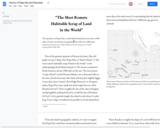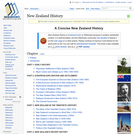
Introduction to the history of Rapa Nui and Polynesia (~7,300 words) for middle and high school students.
- Subject:
- Ethnic Studies
- History
- Social Science
- World History
- Material Type:
- Reading
- Author:
- Jenoge Sora Khatter
- Date Added:
- 05/28/2022

Introduction to the history of Rapa Nui and Polynesia (~7,300 words) for middle and high school students.

This resource is a video abstract of a research paper created by Research Square on behalf of its authors. It provides a synopsis that's easy to understand, and can be used to introduce the topics it covers to students, researchers, and the general public. The video's transcript is also provided in full, with a portion provided below for preview:
"In the past 30 years, the number of children who are overweight or obese has increased by nearly 50 percent. Ads for sugary cereals, soda, and other junk foods are thought to contribute to this rise, but few studies have directly measured how much marketing children see in a typical day. Now, using wearable cameras, researchers in New Zealand have done just that, finding that marketing for unhealthy foods outnumbers that for healthy foods by more than 2 to 1. The scientists recruited children attending various schools in Wellington to wear a small camera, or Kids’Cam, that would take snapshots every 7 seconds to capture marketing exposures. The students were about 12 years old and came from different socioeconomic and ethnic backgrounds. Recording lasted for four days, starting on a Thursday to cover both schooldays and weekends. The team reviewed all of the images from the 168 participants, coding each image for any food marketing..."
The rest of the transcript, along with a link to the research itself, is available on the resource itself.

This International Study Tour went to New Zealand during the first half of the 2016 Spring semester and travel during the Sloan Innovation Period. International Study Tours provide students with a course credit opportunity to identify and address issues about which they feel particularly passionate. After classroom sessions featuring faculty, industry, and cultural experts, students embark on site visits to their destination of choice, meeting with industry and government leaders, as well as local alumni. Through these visits, students are able to build on the preparatory course work with an in-depth exploration of industries, companies, and countries they have visited.
This course fulfills the Sloan Innovation Period (SIP) elective requirement. SIP occurs at the midpoint of each semester providing students with an intensive week of experiential leadership learning, as well as exposure to groundbreaking faculty work. It allows students to engage in intellectual exploration outside the classroom. SIP degree requirements include core courses in ethics and leadership as well as electives.

A concise approach to New Zealand History, this textbook covers the first inhabitants, the Maori, the discovery of New Zealand by the Europeans and some of the significant events that have led up to the way the country is in the present day.
![The Other Fifty Weeks: An Open Education Podcast [Episode 4]](https://img.oercommons.org/160x134/oercommons/media/courseware/lesson/image/16-344-The-Other-Fifty-Weeks-Podbean-v21_GtzHVMa.jpg)
The fourth episode of "The Other Fifty Weeks: An Open Education Podcast", discussing recent recent in New Zeland concerning textbook access and affordability.

This semester, we will read writing about travel and place from Columbus's Diario through the present. Travel writing has some special features that will shape both the content and the work for this subject: reflecting the point of view, narrative choices, and style of individuals, it also responds to the pressures of a real world only marginally under their control. Whether the traveler is a curious tourist, the leader of a national expedition, or a starving, half-naked survivor, the encounter with place shapes what travel writing can be. Accordingly, we will pay attention not only to narrative texts but to maps, objects, archives, and facts of various kinds.
Our materials are organized around three regions: North America, Africa and the Atlantic world, the Arctic and Antarctic. The historical scope of these readings will allow us to know something not only about the experiences and writing strategies of individual travelers, but about the progressive integration of these regions into global economic, political, and knowledge systems. Whether we are looking at the production of an Inuit film for global audiences, or the mapping of a route across the North American continent by water, these materials do more than simply record or narrate experiences and territories: they also participate in shaping the world and what it means to us.
Authors will include Olaudah Equiano, Caryl Philips, Claude Lévi-Strauss, Joseph Conrad, Jamaica Kincaid, William Least Heat Moon, Louise Erdrich, Álvar Núñez Cabeza de Vaca.
Expeditions will include those of Lewis and Clark (North America), Henry Morton Stanley (Africa), Ernest Shackleton and Robert F. Scott (Antarctica).